The August 2017 White2tea club is another learning experience box. This month contains two mid 2000’s sheng puer to compare storage and compression. The Fangcha is dry stored tightly compressed brick with little information known other than it is smokey. The traditional Bingcha is said to be Yiwu origin, loosely pressed, with less compression and humid storage.

Yet another excuse to have some double gaiwan fun, let’s steep!
Dry Leaf
The fangcha is in a spiffy brick.
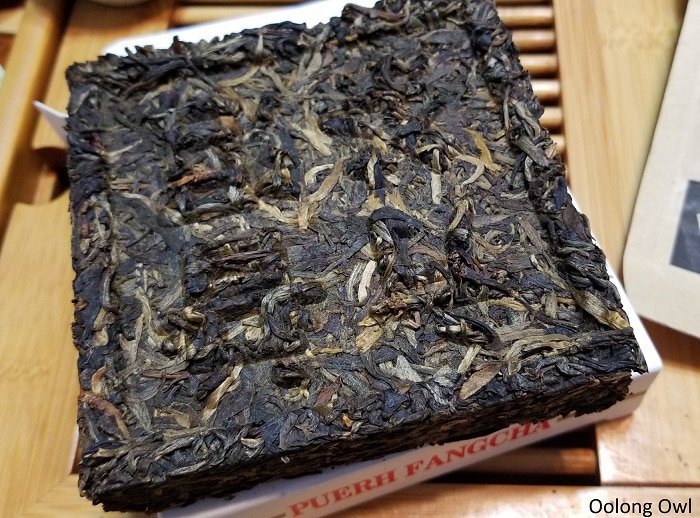
Flipped over, it has warts!
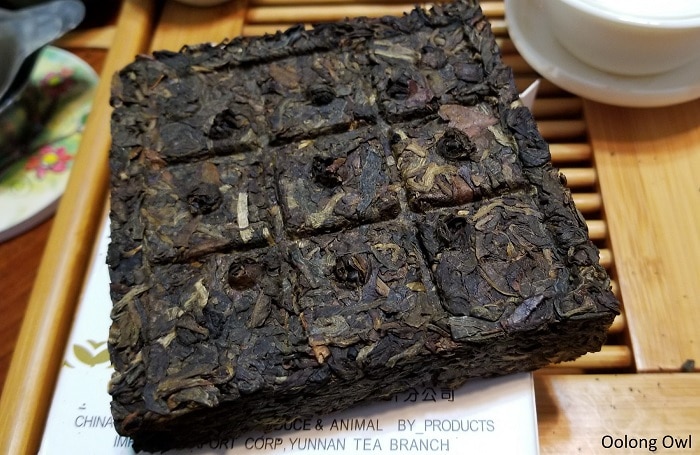
I was warned this brick was a PITA to break, but my folding puer knife got through it like butter.
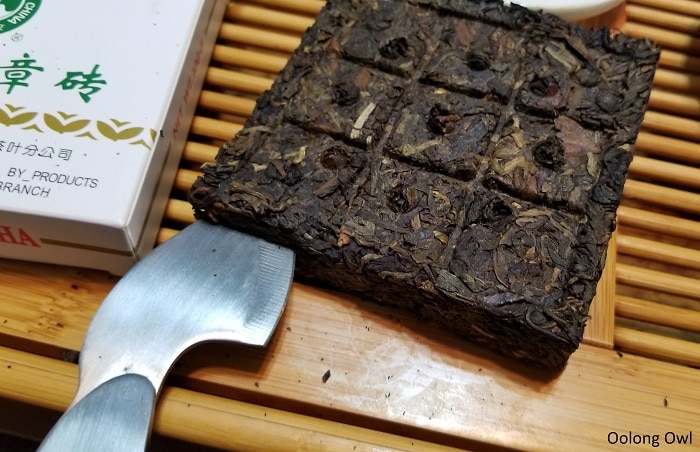
The Bingcha has fairly broken apart, but I selected the most intact piece. The Bingcha got slightly ignored as I was impressed with Fangcha warts.
I felt like over leafing today, so I went for 1 gram per 12ml of vessel size, steeped in boiling water.
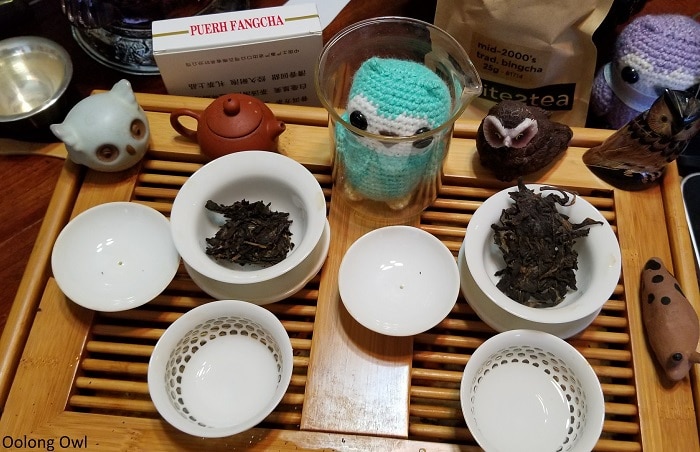
Tasting of August 2017 White2Tea Club Mid 2000’s Sheng Puer
First and Second Infusion:
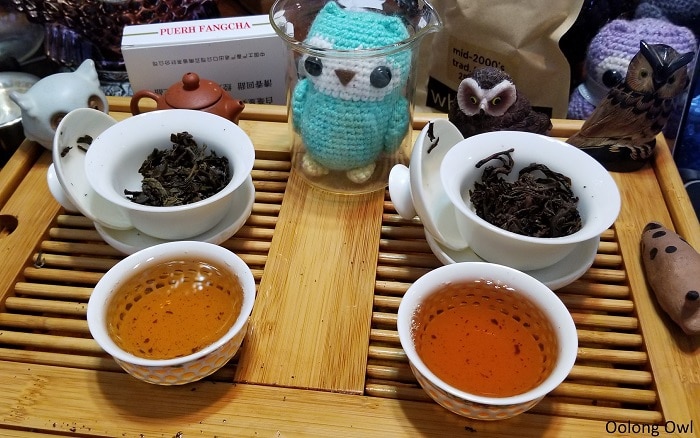
The Fangcha smells like a charred tomato. My brain instantly associated the tomato smell for Hong Shui oolong and wanted to drink that instead. The flavor is an awkward smokey tomato. It’s got some char, tart tomato notes, with a bit of a looseness to the body – it is thick sipping, but the notes flow in and out loosely like chewing a squishy watery tomato. The aftertaste is quite nice, tasting of campfire wood minus the exploding can of beans.
The Bingcha smells like a fruity wet basement. The flavor an has an edge of basement funk, but also a fruity plum note, with a hint of bitterness that skates roughly across the mouth.
Third, Fourth, Fifth, Six, Seventh, and Eighth Infusion:
The bingcha turned red!
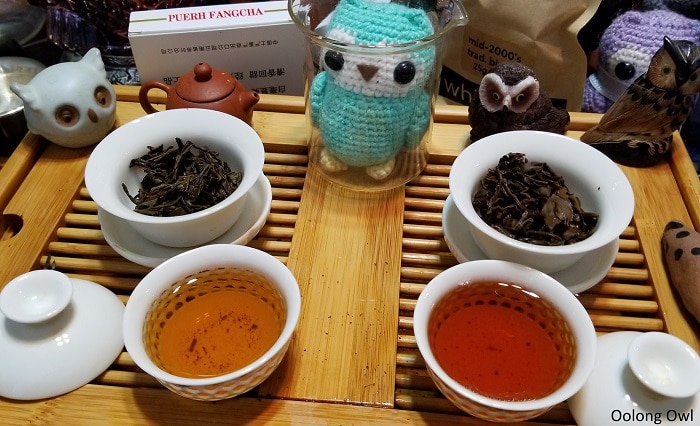
The Fangcha is still smokey. It is losing some of the tomato notes and going for total savory bitter BBQ vegetable skewers with teeth kicking char and woodsy camp aftertaste. The Fangcha has a lot of depth and full flavor. I found this tea more interesting in the body and feel as I drank it if I can ignore the smokey death.
Right at steep three, the basement funk left the Bingcha, leaving a pungently dry, but slightly tart fruity plum tea with a sharp rose floral incense aftertaste. This is actually quite a pleasant drink if you can take the dry texture. I think I used too much leaf for this tea, I would leaf just a touch less next time. These were pretty good infusion as the shift was a pleasant surprise.
Ninth, Tenth, Eleventh, and Twelfth Infusion:
I check out the steeped leaf and see interestingly the Fangcha is greener.

Fangcha is still smokey and savory, but it is chilling out finally. It is mellowy woodsy, a bit of char, and roasted vegetal. Each steeping slips further and further lighter.
Bingcha is a bit temperamental. I feel it reverted back to basement as it has some weird library book/basement notes, some tart, lots of dryness, and on the light side. It isn’t as tart as the last bracket but lost a lot of steam with the fruity notes. The aftertaste is the main flavor of stale floral, but I think I’ve just about killed this tea.
At this point, I feel something is giving out a lot of energy, but I don’t know if it is one tea or combination. I started plotting blending Fangcha with White2Tea Club Baconlog to make the ultimate sandwich.
Steeped up and finished, the leaf shows more contrast. The solid lump of Fangcha is quite chopped up, likely due to tight pressing (maybe material?) and me hacking off bits. It is a touch greener. Bingcha is long, stemmy leaf of a chocolate brown colour. I have more intact leaf likely as one can wiggle and peel pieces out instead of break it like a compressed brick.
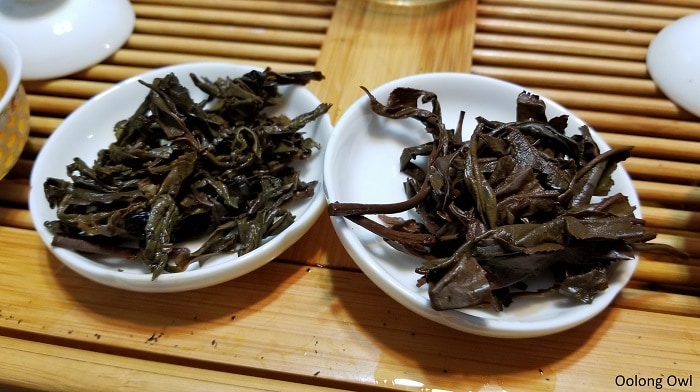
Comments
What a weird trip – both August 2017 mid 2000 puers were unusual. Sorry guys, I lost the information sheet that came with the August 2017 White2Tea club.
The Fangcha I need to tuck away for longer – it was interesting to see in action how the dry storage didn’t age it as much, so it was still green and smokey, yet had interesting depth. I’d hate to drink this any younger, it is a smoke bomb. The Bingcha was sweeter – I can see why many drinkers prefer humid storage. It was a bit of a relief for us who buy a lot of young sweet teas as likely this tea was a sweeter start but aged okay. Both teas had their pros and cons. In the end, an interesting tea session thanks to the White2Tea Club!






